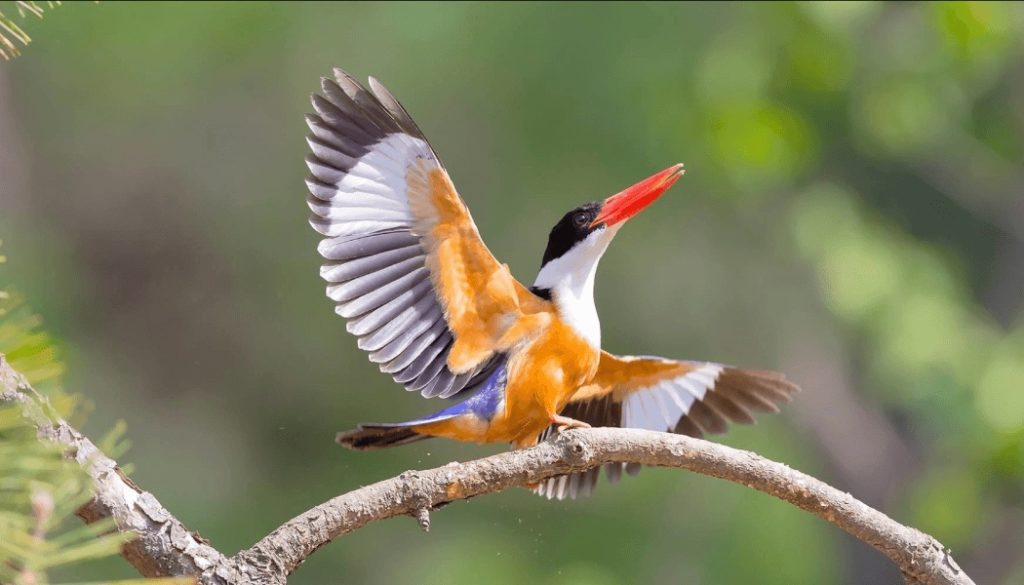This blog post was originally published at TechNexion’s website. It is reprinted here with the permission of TechNexion.
In an era of ever-evolving technology, embedded vision has emerged as a revolutionary tool. By using this technique, we can observe and study wildlife in its natural environment completely remote without any human intrusion. Previously, people had to be physically present to witness this natural phenomenon, which caused disturbances in the delicate ecosystem. Thanks to embedded vision technology, nature enthusiasts and researchers can now immerse themselves in the spectacle from anywhere in the world without disrupting the habitat of these animals! Not only does this bridge the gap between humans and nature, but it also provides a unique viewing experience.
What do We Mean by Remote Animal and Bird-watching?
Bird-watching and animal watching in a general sense refer to researchers and nature enthusiasts viewing birds and animals in their natural habitat by visiting the respective locations. These are not usually places that are easily accessible to the public and do not fall under the list of popular tourist destinations.
However, in this article, we are giving a broader meaning to remote animal and bird-watching by talking about viewing experiences in wildlife reserves & sanctuaries, natural parks, and zoos. Remote watching with the help of embedded cameras makes it possible to offer a complete remote viewing experience of these places to the public.
Advantages of Remote Watching

- The comfort of watching from home: Remote watching offers unparalleled comfort and convenience. Nature enthusiasts can be virtually transported to diverse ecosystems, witnessing wildlife in their natural habitats without leaving the comfort of their own homes. With just a few clicks, viewers can explore and immerse themselves in the spectacular wonders of nature from the convenience of their living rooms.
- No need to commute: Remote watching eliminates the time, energy, and resources associated with traveling to distant natural reserves or parks. With this technology, amazing places around the world are within reach – from dense forests in Africa to serene lakes in the US – without having to worry about long commutes, expenses, or permits, or deal with the hassles of travel.
- Convenient for the elderly and families with kids: Remote watching is a great way for certain groups, such as the elderly or families with young children, to experience natural habitats. By viewing animals in their native environment from the comfort of home, they can feel connected to nature and get closer to wildlife without physical strain and without compromising their safety or comfort.
- Risk-free management for park officials: Remote monitoring is a powerful tool that can help park officials observe and manage wildlife without disturbing them. It reduces the risk of unintentional disruptions to their habitats, allowing animals to be observed in their most natural and undisturbed state. Park officials can also use this technology to conduct research without having to set foot in sensitive areas. In addition, this liberates them from the complexities of managing crowds and vehicles at the park.
- Global reach: Remote watching provides an unparalleled experience of observing the natural world from anywhere in the world. With this global reach, viewers can gain a deeper understanding and appreciation for global biodiversity by witnessing things such as bird migrations in Iceland or lion hunting techniques in the African savannah. Through remote watching, knowledge is gained and a sense of connectivity is established between various ecosystems and cultures across the globe. This also creates new revenue opportunities for wildlife authorities by reaching a global audience.
- Comprehensive coverage: Traditional on-foot or vehicle-based observation has its limitations, such as inaccessible or too risky areas. Remote watching, with its network of strategically placed cameras, can give comprehensive coverage of habitats by observing every nook and corner. This ensures that viewers don’t miss any aspects of the ecosystem they are observing.
How do Camera Modules Make this Possible?
- Live Streaming Using a Network of High-Resolution Cameras: Modern camera modules with high-resolution sensors can capture detailed and crisp images and videos. By strategically placing these cameras in natural habitats, advanced transmission technologies can transfer live footage to be streamed in real-time with clarity over vast distances. This allows viewers to observe the intricate patterns of a bird’s feather or the subtle movements of animals.
- Data Capture for Analytical Insights: Beyond just live streaming, these camera systems are designed to capture vast amounts of data that are processed by the host processor and stored for various types of analyses. This data isn’t just limited to video footage; many modern cameras can capture metadata like timestamps, geolocation, temperature, and more. By analyzing this data, researchers can gain valuable insights into wildlife behavior.
For example, tracking the movement of specific bird species can help scientists determine migration patterns, identify key resting spots, and predict future routes. Seasonal observations also reveal how animals adapt to changing environmental conditions such as hibernation in winter or mating habits in spring. Additionally, monitoring feeding zones can indicate dietary preferences that may be altered by environmental factors. All of this information is invaluable for better understanding ecosystems and the animals that inhabit them. - Remote Operation of Cameras: Modern camera modules offer the ability to be operated remotely by integrating them with communication modules capable of connecting to networks, often wirelessly. With these cameras connected, they can be accessed from anywhere in the world using specialized software or web interfaces, making them ideal for remote monitoring and surveillance solutions. Remote operation of cameras provides several benefits for wildlife observation, including flexibility, safety, and minimal disruption.
Operators can adjust camera settings, change angles, or zoom in and out in real-time so that the audience can get the best possible view. In addition, since no personnel need to be physically present to operate the cameras, there are reduced risks for any hazardous natural habitats. Lastly, the remote operation also ensures that wildlife is observed without being unduly disturbed by human intervention which alters their behavior.
Current Adoption and Future of Embedded Cameras for Remote Bird-Watching

Current Adoption
The use of embedded cameras for remote bird-watching is still in its early stages, but initial implementations have shown great promise.
A prime example is the Ivvavik National Park in Yukon, known for its pristine beauty and diverse wildlife. This park has adopted this technology by installing remote-embedded cameras that allow researchers, park officials, and the general public to observe and study the birds without needing to be there in person. This is beneficial both for conservation efforts and scientific research as it provides valuable data about the avian inhabitants of the park.
Increasing Adoption in the Future
The adoption of embedded cameras for remote animal and bird-watching is set to increase in the coming years due to their convenience and ability to protect wildlife.
With technology becoming more accessible and user-friendly, more locations around the world will find it feasible to install and maintain these camera systems, allowing a broader audience to engage with nature without the need for physical travel. Embedded cameras also help protect wildlife from human interference, ensuring that animals and birds can thrive in their natural habitats without disturbances.
Integration of AI into Embedded Vision Cameras
The future of remote animal and bird-watching includes more than passive observation. The next generation of embedded vision cameras will be far more sophisticated and capable as artificial intelligence (AI) advances.
Following are some of how the integration of AI into embedded vision systems can help remote animal and bird-watching:
- Migration pattern analysis: AI systems can analyze massive volumes of data gathered by cameras to follow and forecast the migration patterns of diverse bird species. This can give vital insights into how natural and man-made environmental changes are impacting these patterns.
- Species count and identification: AI can identify and count different bird species automatically, delivering real-time data on biodiversity and population trends. This is especially important for endangered species conservation efforts.
- Animal behavior analysis: AI can study the behavior of many animals, learning their habits, interactions, and routines, in addition to birds. This can give important information on the health and well-being of animal populations.
- Automated notifications: When AI-enabled cameras detect unusual activity or potential threats to animals, they can send automated notifications to park administrators, allowing for early response.
Selecting the Right Camera for Remote Bird-Watching: Key Features to Consider

VLS3-AR0822-CB
- High Resolution: With a resolution of 4K and above, wildlife and bird watchers can observe intricate details that they may otherwise miss. This level of resolution offers four times (or higher) the detail of standard 1080p cameras. So when you zoom in, the image remains sharp and clear, preventing pixelation. With a high-resolution image, viewers can appreciate minute details including the patterns on a bird’s plumage or subtle movements from distant animals.
- PTZ (Pan Tilt Zoom) Functionality: A PTZ camera allows you to cover vast areas with features such as (the combination of these motions gives complete coverage, guaranteeing that nothing goes unnoticed):
- Pan: This allows the camera to move from side to side, allowing for a horizontal perspective of the surroundings.
- Tilt: This allows for vertical movement, allowing the camera to record subjects at various heights.
- Zoom: Designed to focus on specific locations, animals, or birds, thereby allowing for a closer look without moving the camera.
- Enclosure for Harsh Conditions: When designing outdoor cameras, it is important to consider the unpredictable nature of the environment and ensure that they are capable of withstanding varying conditions, such as rain, snow, dust, and heat. To do this, IP66, IP67, or IP68-rated enclosures should be used. These ratings guarantee that the cameras will remain dust-proof and can withstand powerful water jets or extended immersion in water, making them suitable for any outdoor location.
- IR Sensitivity and IR Cut Filter: Wildlife watching can be done both day and night. To capture animals at night, the camera needs to be equipped with infrared (IR) sensitivity. This will allow it to record quality footage even in dark conditions. During the day, an IR-cut filter should be used for improved image quality. The filter will prevent infrared light from being captured, giving you vibrant, true-to-life colors. For convenience, cameras should come with a feature that switches off the filter automatically during the night. Also read IR-Cut Filter in Embedded Vision.
How TechNexion can Contribute to Remote Animal and Bird-watching
If you are into building camera-enabled surveillance and monitoring systems, and you love nature, you should consider building a remote animal and bird-watching system, preferably one that can be integrated with AI capabilities.
TechNexion can be your imaging companion in that journey. We design, build, and manufacture camera modules that have all the features necessary for capturing sharp images, plus unparalleled durability and reliability. With decades of excellence in the industry and a commitment to innovation, TechNexion’s cameras are an ideal choice for anyone looking to explore the world of remote bird-watching. Learn more about our embedded cameras here.


